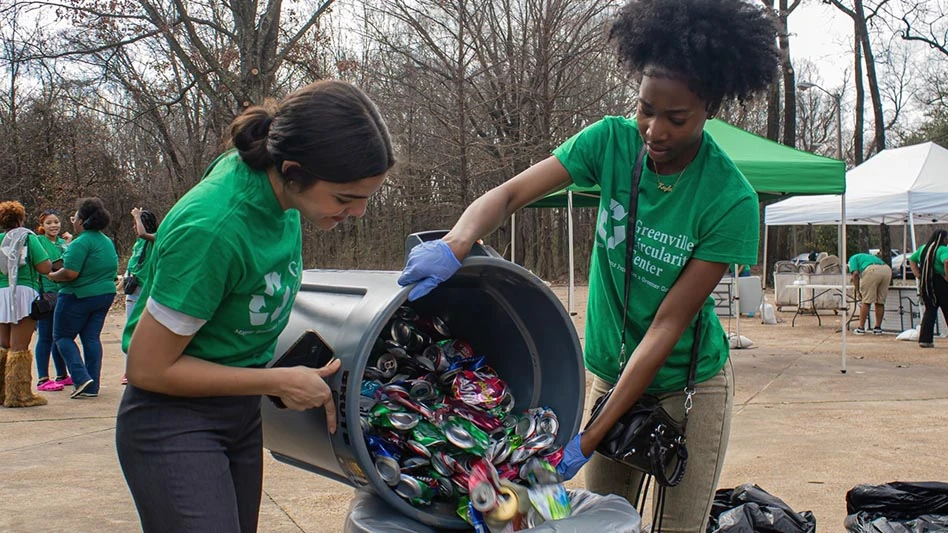
FCC Houston MRF installs RoBB-AQC
FCC Environmental Services, with administrative offices in The Woodlands, Texas, has added a Bollegraaf RoBB-AQC robotic sorter to its material recovery facility (MRF) in Houston.
The sorter was supplied by Van Dyk Recycling Solutions of Norwalk, Connecticut, in October of last year. Van Dyk previously supplied FCC with the MRF’s sorting system, which was recognized n 2020 by the National Waste & Recycling Association.
When the RoBB-AQC arrived in Houston, FCC Director of Recycling Andrea Rodriguez-Piñero says she was impressed. “When RoBB showed up, it fit perfectly on top of the feed conveyor,” she says. “We have been very happy with the quality of the Bollegraaf equipment that we installed in our Dallas and Houston facilities over the last six years, and this is no exception.”
Supplier Van Dyk and manufacturer Bollegraaf Recycling Solutions, based in the Netherlands, say they paid close attention during the design process to deliver a machine that would be easy to install with little disruption. They also ensured that the design would live up to performance expectations.
FCC is using the RoBB-AQC on its mixed paper quality control line. It has two sorting tasks: recovering outthrows of old corrugated containers and prohibitives (bottles, cans and film).
RoBB-AQC helps FCC improve mixed paper quality while recovering high-value aluminum, polyethylene terephthalate and OCC.
Bollegraaf and Van Dyk also designed ergonomic feed hoppers and chutes to maximize RoBB’s accuracy. The artificial intelligence software, robotic arm and the location and design of the feed hoppers and chutes all play roles in RoBB-AQC’s performance.
Rodriguez-Piñero says, “The feed hoppers are in just the right place to accept RoBB’s throws and are sloped in such a way so that throws don’t bounce out. The chutes flow into the bunkers in such a way that products are directed away from the chute to prevent clogging. You can really tell the equipment has come from an experienced system and retrofit builder.”
Another advantage of RoBB-AQC is that it works with one arm on wide conveyors, allowing it to be installed without making any conveyor changes.
“Safety always influences our decisions at FCC,” Rodriguez-Piñero says. “The RoBB is installed with a total enclosure, so no one can access the arm of the robot while the machine is working. Bollegraaf designs their equipment keeping the safety of the end user in mind, and this was a very important factor in our decision-making.”
Another important factor in FCC’s decision-making process was the ability to outfit the RoBB-AQC with near- infrared (NIR) recognition technology from Tomra, which is known for its optical sorters. In addition to NIR recognition, RoBB-AQC has multiple sensors, including camera, laser and metal detection, for identifying objects.
Wendt sells preshredder to Indiana scrap recycler
Buffalo, New York-based Wendt Corp. has announced the sale of a Wendt/MTB EZR Pre-Shredder to Indiana-based Rochester Iron & Metal. Although several EZRs have been installed worldwide, Rochester will be the first U.S. installation, Wendt says. The unit is scheduled to be installed and operational in the fourth quarter of 2021.
Wendt describes Rochester Iron & Metal as a fourth-generation, family-owned business with predecessor companies that have been serving the scrap industry since the early 1900s. Jason Grube and his stepfather, Mooch Lewis, partnered to form Rochester Iron & Metal in 2002.
After installing one of the first Wendt M6090 shredding plants in 2012, the company has expanded from 17 employees to more than 100. Rochester’s growth became apparent in 2013, a year after the shredder was installed. “Initially our estimates for the shredder were 4,000 tons a month,” says Grube, who is president of the firm. “By the end of 2012, we were at capacity with 10,000 to 11,000 tons per month.”
Growth and operating heavy equipment also bring challenges. In late 2018, Rochester Iron & Metal had a massive unshreddable introduced into its mill. After initially being told the shredder would be inoperable for up to six months, the company made significant changes.
“We were very fortunate that we were back up and running within four days,” Grube says. “However, we never want to be in that situation again. We have spent a lot of money over the last few years buying spare parts in case that single event was ever to occur again. By purchasing the preshredder, we’ve invested in insurance that those events are going to be less likely now than ever before.”
The preshredder uses low-speed, high-torque technology to homogenize hammermill feedstock. This allows the main shredder to achieve “full box shredding,” increasing tons per hour while decreasing the wear on castings, Wendt says.
Preshredders give operators the ability to catch and remove unshreddables prior to the main shredder, reducing the chances of catastrophic failure at the mill. By operating at a slow speed, preshredders can puncture explosive containers without creating an ignition source that is typical in a hammermill.
Rochester’s EZR Pre-Shredder is capable of handling up to 70 tons per hour and features the same modular features that Wendt has introduced in its other equipment lines.

Explore the June 2021 Issue
Check out more from this issue and find your next story to read.
Latest from Recycling Today
- OnePlanet Solar Recycling closes $7M seed financing round
- AMCS launches AMCS Platform Spring 2025 update
- Cyclic Materials to build rare earth recycling facility in Mesa, Arizona
- Ecobat’s Seculene product earns recognition for flame-retardant properties
- IWS’ newest MRF is part of its broader strategy to modernize waste management infrastructure
- PCA reports profitable Q1
- British Steel mill subject of UK government intervention
- NRC seeks speakers for October event





